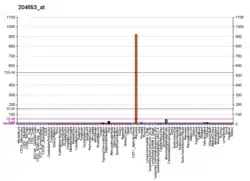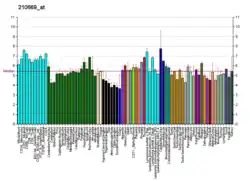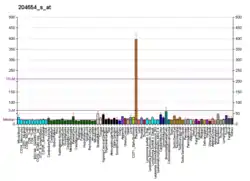TFAP2A
Transcription factor AP-2 alpha (Activating enhancer binding Protein 2 alpha), also known as TFAP2A, is a protein that in humans is encoded by the TFAP2A gene.[5]
Function
The AP-2 alpha protein acts as a sequence-specific DNA-binding transcription factor recognizing and binding to the specific DNA sequence and recruiting transcription machinery. Its binding site is a GC-rich sequence that is present in the cis-regulatory regions of several viral and cellular genes.[6] AP2-alpha is a 52-kD retinoic acid-inducible and developmentally regulated activator of transcription that binds to a consensus DNA-binding sequence GCCNNNGGC in the SV40 and metallothionein promoters.[5]
AP-2 alpha is expressed in neural crest cell lineages with the highest levels of expression corresponding to early neural crest cells, suggesting that AP-2 alpha plays a role in their differentiation and development. Transcription factor AP-2 alpha is expressed in ectoderm and in neural-crest cells migrating from the cranial folds during closure of the neural tube in the mouse. Cranial neural crest cell provides patterning information for craniofacial morphogenesis and generate most of the skull bones and the cranial ganglia.[6][7][8][9]
AP-2 alpha knockout mice die perinatally with cranio-abdominoschisis and severe dysmorphogenesis of the face, skull, sensory organs, and cranial ganglia.[10] Homozygous knockout mice also have neural tube defects followed by craniofacial and body wall abnormalities.[11] In vivo gene delivery of AP-2 alpha suppressed spontaneous intestinal polyps in the Apc(Min/+) mouse.[12] AP-2 alpha also functions as a master regulator of multiple transcription factors in the mouse liver.[13]
In melanocytic cells TFAP2A gene expression may be regulated by MITF.[14]
Clinical significance
Mutations in the TFAP2A gene cause Branchio-oculo-facial syndrome often with a midline cleft lip.[15] In a family with branchio-oculo-facial syndrome (BOFS),[16] a 3.2-Mb deletion at chromosome 6p24.3 was detected.[17] Sequencing of candidate genes in that region in 4 additional unrelated BOFS patients revealed 4 different de novo missense mutations in the exons 4 and 5 of the TFAP2A gene.
A disruption of an AP-2 alpha binding site in an IRF6 enhancer is associated with cleft lip.[18] Mutations in IRF6 gene cause Van der Woude syndrome (VWS)[19] that is a rare mendelian clefting autossomal dominant disorder with lower lip pits in 85% of affected individuals.[20] The remaining 15% of individuals with Van der Woude syndrome show only cleft lip and/or cleft palate (CL/P) and are clinically indistinguishable from the common non syndromic CL/P. NSCL/P occur in approximately 1/700 live births and is one of the most common form of congenital abnormalities. A previous association study between SNPs in and around IRF6 and NSCL/P have shown significant results in different populations[21] and was independently replicated.[22][23][24][25]
A search of NSCL/P cases for potential regulatory elements for IRF6 gene was made aligning genomic sequences to a 500 Kb region encompassing IRF6 from 17 vertebrate species. Human sequence as reference and searched for multispecies conserved sequences (MCSs). Regions contained in introns 5’ and 3’ flanking IRF6 were screened by direct sequencing for potential causative variants in 184 NSCL/P cases. The rare allele of the SNP rs642961 showed a significant association with cleft lip cases. Analysis of transcription factor binding site analysis showed that the risk allele disrupt a binding site for AP-2 alpha.[18]
Mutations in the AP-2 alpha gene also cause branchio-oculo-facial syndrome,[17] which has overlapping features with Van der Woude syndrome such as orofacial clefting and occasional lip pits what make rs642961 a good candidate for an etiological variant. These findings show that IRF6 and AP-2 alpha are in the same developmental pathway and identify a variant in a regulatory region that contributes substantially to a common complex disorder.
Interactions
TFAP2A has been shown to interact with:
References
- GRCh38: Ensembl release 89: ENSG00000137203 - Ensembl, May 2017
- GRCm38: Ensembl release 89: ENSMUSG00000021359 - Ensembl, May 2017
- "Human PubMed Reference:". National Center for Biotechnology Information, U.S. National Library of Medicine.
- "Mouse PubMed Reference:". National Center for Biotechnology Information, U.S. National Library of Medicine.
- "Entrez Gene: TFAP2A transcription factor AP-2 alpha (activating enhancer binding protein 2 alpha)".
- Williams T, Tjian R (Apr 1991). "Analysis of the DNA-binding and activation properties of the human transcription factor AP-2". Genes & Development. 5 (4): 670–82. doi:10.1101/gad.5.4.670. PMID 2010091.
- Mitchell PJ, Wang C, Tjian R (Sep 1987). "Positive and negative regulation of transcription in vitro: enhancer-binding protein AP-2 is inhibited by SV40 T antigen". Cell. 50 (6): 847–61. doi:10.1016/0092-8674(87)90512-5. PMID 3040262. S2CID 25657738.
- Williams T, Admon A, Lüscher B, Tjian R (Dec 1988). "Cloning and expression of AP-2, a cell-type-specific transcription factor that activates inducible enhancer elements". Genes & Development. 2 (12A): 1557–69. doi:10.1101/gad.2.12a.1557. PMID 3063603.
- Le Douarin NM, Ziller C, Couly GF (Sep 1993). "Patterning of neural crest derivatives in the avian embryo: in vivo and in vitro studies". Developmental Biology. 159 (1): 24–49. doi:10.1006/dbio.1993.1219. PMID 8365563.
- Schorle H, Meier P, Buchert M, Jaenisch R, Mitchell PJ (May 1996). "Transcription factor AP-2 essential for cranial closure and craniofacial development". Nature. 381 (6579): 235–8. Bibcode:1996Natur.381..235S. doi:10.1038/381235a0. PMID 8622765. S2CID 581362.
- Zhang J, Hagopian-Donaldson S, Serbedzija G, Elsemore J, Plehn-Dujowich D, McMahon AP, Flavell RA, Williams T (May 1996). "Neural tube, skeletal and body wall defects in mice lacking transcription factor AP-2". Nature. 381 (6579): 238–41. Bibcode:1996Natur.381..238Z. doi:10.1038/381238a0. PMID 8622766. S2CID 4367622.
- Li Q, Löhr CV, Dashwood RH (Sep 2009). "Activator protein 2alpha suppresses intestinal tumorigenesis in the Apc(min) mouse". Cancer Letters. 283 (1): 36–42. doi:10.1016/j.canlet.2009.03.026. PMC 2713803. PMID 19376641.
- Li Q, Luo C, Löhr CV, Dashwood RH (Aug 2011). "Activator protein-2α functions as a master regulator of multiple transcription factors in the mouse liver". Hepatology Research. 41 (8): 776–83. doi:10.1111/j.1872-034X.2011.00827.x. PMC 4139281. PMID 21682828.
- Hoek KS, Schlegel NC, Eichhoff OM, Widmer DS, Praetorius C, Einarsson SO, Valgeirsdottir S, Bergsteinsdottir K, Schepsky A, Dummer R, Steingrimsson E (Dec 2008). "Novel MITF targets identified using a two-step DNA microarray strategy". Pigment Cell & Melanoma Research. 21 (6): 665–76. doi:10.1111/j.1755-148X.2008.00505.x. PMID 19067971. S2CID 24698373.
- Dixon MJ, Marazita ML, Beaty TH, Murray JC (2011). "Cleft lip and palate: understanding genetic and environmental influences". Nature Reviews Genetics (12): 167-178.
- Online Mendelian Inheritance in Man (OMIM): 113620
- Milunsky JM, Maher TA, Zhao G, Roberts AE, Stalker HJ, Zori RT, Burch MN, Clemens M, Mulliken JB, Smith R, Lin AE (May 2008). "TFAP2A mutations result in branchio-oculo-facial syndrome". American Journal of Human Genetics. 82 (5): 1171–7. doi:10.1016/j.ajhg.2008.03.005. PMC 2427243. PMID 18423521.
- Rahimov F, Marazita ML, Visel A, Cooper ME, Hitchler MJ, Rubini M, Domann FE, Govil M, Christensen K, Bille C, Melbye M, Jugessur A, Lie RT, Wilcox AJ, Fitzpatrick DR, Green ED, Mossey PA, Little J, Steegers-Theunissen RP, Pennacchio LA, Schutte BC, Murray JC (Nov 2008). "Disruption of an AP-2alpha binding site in an IRF6 enhancer is associated with cleft lip". Nature Genetics. 40 (11): 1341–7. doi:10.1038/ng.242. PMC 2691688. PMID 18836445.
- Online Mendelian Inheritance in Man (OMIM): 119300
- Kondo S, Schutte BC, Richardson RJ, Bjork BC, Knight AS, Watanabe Y, Howard E, de Lima RL, Daack-Hirsch S, Sander A, McDonald-McGinn DM, Zackai EH, Lammer EJ, Aylsworth AS, Ardinger HH, Lidral AC, Pober BR, Moreno L, Arcos-Burgos M, Valencia C, Houdayer C, Bahuau M, Moretti-Ferreira D, Richieri-Costa A, Dixon MJ, Murray JC (Oct 2002). "Mutations in IRF6 cause Van der Woude and popliteal pterygium syndromes". Nature Genetics. 32 (2): 285–9. doi:10.1038/ng985. PMC 3169431. PMID 12219090.
- Zucchero TM, Cooper ME, Maher BS, Daack-Hirsch S, Nepomuceno B, Ribeiro L, Caprau D, Christensen K, Suzuki Y, Machida J, Natsume N, Yoshiura K, Vieira AR, Orioli IM, Castilla EE, Moreno L, Arcos-Burgos M, Lidral AC, Field LL, Liu YE, Ray A, Goldstein TH, Schultz RE, Shi M, Johnson MK, Kondo S, Schutte BC, Marazita ML, Murray JC (Aug 2004). "Interferon regulatory factor 6 (IRF6) gene variants and the risk of isolated cleft lip or palate". The New England Journal of Medicine. 351 (8): 769–80. doi:10.1056/NEJMoa032909. PMID 15317890.
- Scapoli L, Palmieri A, Martinelli M, Pezzetti F, Carinci P, Tognon M, Carinci F (Jan 2005). "Strong evidence of linkage disequilibrium between polymorphisms at the IRF6 locus and nonsyndromic cleft lip with or without cleft palate, in an Italian population". American Journal of Human Genetics. 76 (1): 180–3. doi:10.1086/427344. PMC 1196422. PMID 15558496.
- Blanton SH, Cortez A, Stal S, Mulliken JB, Finnell RH, Hecht JT (Sep 2005). "Variation in IRF6 contributes to nonsyndromic cleft lip and palate". American Journal of Medical Genetics Part A. 137A (3): 259–62. doi:10.1002/ajmg.a.30887. PMID 16096995. S2CID 25084563.
- Ghassibé M, Bayet B, Revencu N, Verellen-Dumoulin C, Gillerot Y, Vanwijck R, Vikkula M (Nov 2005). "Interferon regulatory factor-6: a gene predisposing to isolated cleft lip with or without cleft palate in the Belgian population". European Journal of Human Genetics. 13 (11): 1239–42. doi:10.1038/sj.ejhg.5201486. PMID 16132054.
- Park JW, McIntosh I, Hetmanski JB, Jabs EW, Vander Kolk CA, Wu-Chou YH, Chen PK, Chong SS, Yeow V, Jee SH, Park BY, Fallin MD, Ingersoll R, Scott AF, Beaty TH (Apr 2007). "Association between IRF6 and nonsyndromic cleft lip with or without cleft palate in four populations". Genetics in Medicine. 9 (4): 219–27. doi:10.1097/GIM.0b013e3180423cca. PMC 2846512. PMID 17438386.
- Li Q, Dashwood RH (Oct 2004). "Activator protein 2alpha associates with adenomatous polyposis coli/beta-catenin and Inhibits beta-catenin/T-cell factor transcriptional activity in colorectal cancer cells". The Journal of Biological Chemistry. 279 (44): 45669–75. doi:10.1074/jbc.M405025200. PMC 2276578. PMID 15331612.
- Bragança J, Eloranta JJ, Bamforth SD, Ibbitt JC, Hurst HC, Bhattacharya S (May 2003). "Physical and functional interactions among AP-2 transcription factors, p300/CREB-binding protein, and CITED2". The Journal of Biological Chemistry. 278 (18): 16021–9. doi:10.1074/jbc.M208144200. PMID 12586840.
- Bragança J, Swingler T, Marques FI, Jones T, Eloranta JJ, Hurst HC, Shioda T, Bhattacharya S (Mar 2002). "Human CREB-binding protein/p300-interacting transactivator with ED-rich tail (CITED) 4, a new member of the CITED family, functions as a co-activator for transcription factor AP-2". The Journal of Biological Chemistry. 277 (10): 8559–65. doi:10.1074/jbc.M110850200. PMID 11744733.
- Campillos M, García MA, Valdivieso F, Vázquez J (Mar 2003). "Transcriptional activation by AP-2alpha is modulated by the oncogene DEK". Nucleic Acids Research. 31 (5): 1571–5. doi:10.1093/nar/gkg247. PMC 149840. PMID 12595566.
- Gaubatz S, Imhof A, Dosch R, Werner O, Mitchell P, Buettner R, Eilers M (Apr 1995). "Transcriptional activation by Myc is under negative control by the transcription factor AP-2". The EMBO Journal. 14 (7): 1508–19. doi:10.1002/j.1460-2075.1995.tb07137.x. PMC 398238. PMID 7729426.
- McPherson LA, Loktev AV, Weigel RJ (Nov 2002). "Tumor suppressor activity of AP2alpha mediated through a direct interaction with p53". The Journal of Biological Chemistry. 277 (47): 45028–33. doi:10.1074/jbc.M208924200. PMID 12226108.
Further reading
- Murphy JE, Keen JH (May 1992). "Recognition sites for clathrin-associated proteins AP-2 and AP-3 on clathrin triskelia". The Journal of Biological Chemistry. 267 (15): 10850–5. PMID 1587861.
- Gaynor RB, Muchardt C, Xia YR, Klisak I, Mohandas T, Sparkes RS, Lusis AJ (Aug 1991). "Localization of the gene for the DNA-binding protein AP-2 to human chromosome 6p22.3-pter". Genomics. 10 (4): 1100–2. doi:10.1016/0888-7543(91)90209-W. PMID 1916817.
- Williams T, Tjian R (Mar 1991). "Characterization of a dimerization motif in AP-2 and its function in heterologous DNA-binding proteins". Science. 251 (4997): 1067–71. Bibcode:1991Sci...251.1067W. doi:10.1126/science.1998122. PMID 1998122.
- Williams T, Tjian R (Apr 1991). "Analysis of the DNA-binding and activation properties of the human transcription factor AP-2". Genes & Development. 5 (4): 670–82. doi:10.1101/gad.5.4.670. PMID 2010091.
- Williams T, Admon A, Lüscher B, Tjian R (Dec 1988). "Cloning and expression of AP-2, a cell-type-specific transcription factor that activates inducible enhancer elements". Genes & Development. 2 (12A): 1557–69. doi:10.1101/gad.2.12a.1557. PMID 3063603.
- Bauer R, Imhof A, Pscherer A, Kopp H, Moser M, Seegers S, Kerscher M, Tainsky MA, Hofstaedter F, Buettner R (Apr 1994). "The genomic structure of the human AP-2 transcription factor". Nucleic Acids Research. 22 (8): 1413–20. doi:10.1093/nar/22.8.1413. PMC 307999. PMID 8190633.
- Buettner R, Kannan P, Imhof A, Bauer R, Yim SO, Glockshuber R, Van Dyke MW, Tainsky MA (Jul 1993). "An alternatively spliced mRNA from the AP-2 gene encodes a negative regulator of transcriptional activation by AP-2". Molecular and Cellular Biology. 13 (7): 4174–85. doi:10.1128/mcb.13.7.4174. PMC 359967. PMID 8321221.
- Williamson JA, Bosher JM, Skinner A, Sheer D, Williams T, Hurst HC (Jul 1996). "Chromosomal mapping of the human and mouse homologues of two new members of the AP-2 family of transcription factors". Genomics. 35 (1): 262–4. doi:10.1006/geno.1996.0351. PMID 8661133.
- Pirozzi G, McConnell SJ, Uveges AJ, Carter JM, Sparks AB, Kay BK, Fowlkes DM (Jun 1997). "Identification of novel human WW domain-containing proteins by cloning of ligand targets". The Journal of Biological Chemistry. 272 (23): 14611–6. doi:10.1074/jbc.272.23.14611. PMID 9169421.
- Batsché E, Muchardt C, Behrens J, Hurst HC, Crémisi C (Jul 1998). "RB and c-Myc activate expression of the E-cadherin gene in epithelial cells through interaction with transcription factor AP-2". Molecular and Cellular Biology. 18 (7): 3647–58. doi:10.1128/mcb.18.7.3647. PMC 108947. PMID 9632747.
- Mertens PR, Alfonso-Jaume MA, Steinmann K, Lovett DH (Dec 1998). "A synergistic interaction of transcription factors AP2 and YB-1 regulates gelatinase A enhancer-dependent transcription". The Journal of Biological Chemistry. 273 (49): 32957–65. doi:10.1074/jbc.273.49.32957. PMID 9830047.
- García MA, Campillos M, Marina A, Valdivieso F, Vázquez J (Feb 1999). "Transcription factor AP-2 activity is modulated by protein kinase A-mediated phosphorylation". FEBS Letters. 444 (1): 27–31. doi:10.1016/S0014-5793(99)00021-6. PMID 10037142. S2CID 43874770.
- Rosenthal JA, Chen H, Slepnev VI, Pellegrini L, Salcini AE, Di Fiore PP, De Camilli P (Nov 1999). "The epsins define a family of proteins that interact with components of the clathrin coat and contain a new protein module". The Journal of Biological Chemistry. 274 (48): 33959–65. doi:10.1074/jbc.274.48.33959. PMID 10567358.
- Heicklen-Klein A, Ginzburg I (Oct 2000). "Tau promoter confers neuronal specificity and binds Sp1 and AP-2". Journal of Neurochemistry. 75 (4): 1408–18. doi:10.1046/j.1471-4159.2000.0751408.x. PMID 10987820. S2CID 6558429.
- Nyormoi O, Wang Z, Doan D, Ruiz M, McConkey D, Bar-Eli M (Aug 2001). "Transcription factor AP-2alpha is preferentially cleaved by caspase 6 and degraded by proteasome during tumor necrosis factor alpha-induced apoptosis in breast cancer cells". Molecular and Cellular Biology. 21 (15): 4856–67. doi:10.1128/MCB.21.15.4856-4867.2001. PMC 87191. PMID 11438643.
- Rao DS, Chang JC, Kumar PD, Mizukami I, Smithson GM, Bradley SV, Parlow AF, Ross TS (Nov 2001). "Huntingtin interacting protein 1 Is a clathrin coat binding protein required for differentiation of late spermatogenic progenitors". Molecular and Cellular Biology. 21 (22): 7796–806. doi:10.1128/MCB.21.22.7796-7806.2001. PMC 99949. PMID 11604514.
- Bragança J, Swingler T, Marques FI, Jones T, Eloranta JJ, Hurst HC, Shioda T, Bhattacharya S (Mar 2002). "Human CREB-binding protein/p300-interacting transactivator with ED-rich tail (CITED) 4, a new member of the CITED family, functions as a co-activator for transcription factor AP-2". The Journal of Biological Chemistry. 277 (10): 8559–65. doi:10.1074/jbc.M110850200. PMID 11744733.
- Mertens PR, Steinmann K, Alfonso-Jaume MA, En-Nia A, Sun Y, Lovett DH (Jul 2002). "Combinatorial interactions of p53, activating protein-2, and YB-1 with a single enhancer element regulate gelatinase A expression in neoplastic cells". The Journal of Biological Chemistry. 277 (28): 24875–82. doi:10.1074/jbc.M200445200. PMID 11973333.
- Eloranta JJ, Hurst HC (Aug 2002). "Transcription factor AP-2 interacts with the SUMO-conjugating enzyme UBC9 and is sumolated in vivo". The Journal of Biological Chemistry. 277 (34): 30798–804. doi:10.1074/jbc.M202780200. PMID 12072434.
- Ben-Zimra M, Koler M, Orly J (Aug 2002). "Transcription of cholesterol side-chain cleavage cytochrome P450 in the placenta: activating protein-2 assumes the role of steroidogenic factor-1 by binding to an overlapping promoter element". Molecular Endocrinology. 16 (8): 1864–80. doi:10.1210/me.2002-0056. PMID 12145340.
External links
- GeneReviews/NCBI/NIH/UW entry on Branchiooculofacial Syndrome
- TFAP2A+protein,+human at the US National Library of Medicine Medical Subject Headings (MeSH)
- FactorBook AP-2alpha
- TFAP2A human gene location in the UCSC Genome Browser.
- TFAP2A human gene details in the UCSC Genome Browser.
This article incorporates text from the United States National Library of Medicine, which is in the public domain.






